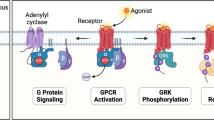Abstract.
Adenosine 5′-triphosphate (ATP), in addition to its intracellular roles, acts as an extracellular signalling molecule via a rich array of receptors, which have been cloned and characterised. P1 receptors are selective for adenosine, a breakdown product of ATP, produced after degradation by ectonucleotidases. Four subtypes have been identified, A1, A2A, A2B and A3 receptors. P2 receptors are activated by purines and some subtypes also by pyrimidines. P2X receptors are ligand-gated ion channel receptors and seven subunits have been identified, which form both homomultimers and heteromultimers. P2Y receptors are G protein-coupled receptors, and eight subtypes have been cloned and characterised to date.
Similar content being viewed by others
Author information
Authors and Affiliations
Corresponding author
Additional information
Received 22 November 2006; received after revision 11 January 2007; accepted 27 February 2007
Rights and permissions
About this article
Cite this article
Burnstock, G. Purine and pyrimidine receptors. Cell. Mol. Life Sci. 64, 1471 (2007). https://doi.org/10.1007/s00018-007-6497-0
Published:
DOI: https://doi.org/10.1007/s00018-007-6497-0




